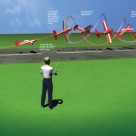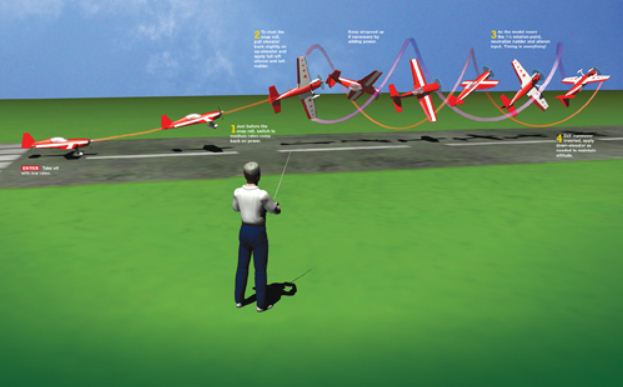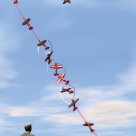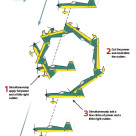تیک آف همراه با اسنپ
نوشته شده توسط admin در دسته مانور هوایی - حرکات نمایشی -, مفاهیم پایه | بدون نظر

مانور ی بلافاصله بعد از بلند شدن ( تیک آف )
Takeoff with a Snap Aug 01, 2012 1 Comment by Debra Cleghorn If you are aspiring to become a better aerobatic pilot, no doubt you’re constantly searching to add excitement and variety to your flying. After all, the best aerobatic pilots are skilled when it comes to combining certain elements from one maneuver with elements from another. This month, I would like to combine the snap roll with a takeoff, so you can get attention on your flight right from the start! Before we get into a deep discussion about this eye-catching aerobatic move, we will begin by taking a look at your aircraft and how it is set up with respect to dual rates and exponential settings. Now, let’s get down to business! FIRST THINGS FIRST Many aerobatic airplanes today are advertised as being “۳D-capable,” and they have very large control surfaces so that they can perform maneuvers while in a stalled condition. However, having large control surfaces and a lot of control surface deflection is not needed for any maneuver that isn’t considered “۳D” and, with respect to this month’s move, a lot of control deflection is not needed. The goal is to perform a precise 1½ positive snap on takeoff’nice, crisp and clean! If you usually read my columns, you are aware of the fact that I prefer to use flight modes, with my dual and/or triple rates on one switch. This means that my aileron, elevator and rudder rates are on one switch. To perform the combo maneuver of the month, I prefer to use two flight modes. On my lowest rate, I have about 15 degrees of aileron, 12 degrees of elevator and 35 degrees of rudder deflection with 20-, 25- and 50-percent exponential, respectively. On my second rate, I have about 30 degrees of aileron, 25 degrees of elevator and 32 degrees of rudder deflection and 45-percent exponential on all of these surfaces. Keep in mind that values differ from airplane to airplane. When I perform any takeoff and landing, I am always on my low rate settings. Where I perform a stunt like a snap roll only feet from the ground, I switch to my mid rate settings right before the snap roll and switch back to my low rate setting when the snap roll is completed. While everyone has different personal preferences, this is the setup that has worked best for me as I do not want my aircraft to be sensitive while flying on low rates. No matter what size aircraft you are flying, whether it is a small park flyer or giant-scale, always take advantage of flight modes and adjust each rate as needed to cater to your liking. For example, once flying, if you move the aileron stick to its maximum and the roll rate of the aircraft is slow, increase the dual rate for that given rate. Similarly, if you feel that the airplane is too quick to respond around neutral but the endpoint value is great (the dual rate value), increase the amount of exponential you are using. Do this test on all control surfaces. OVERVIEW OF A 1 ½ POSITIVE SNAP ON TAKEOFF Before attempting the 1½ positive snap on takeoff, you should be proficient with performing positive snap rolls in general. When you execute this move, you must be in complete control and exit the maneuver at a safe altitude. Do not drop altitude throughout the snap roll as this can be fatal when you’re only feet from the ground! Depending on the power to weight ratio of your aircraft, your throttle percentage may differ slightly. On most of my models, I prefer to apply almost maximum power throughout the takeoff roll and then decrease power slightly once the airplane breaks ground. Then I pitch the airplane up slightly by pulling back on the elevator control stick and apply the same direction rudder and aileron. I’ll release elevator to unload the airplane and ensure that it does not drop any altitude through the rotation. Then, once inverted and after 1 ½ snaps have been performed, I’ll release aileron and rudder input and apply a touch of down-elevator to sustain level inverted flight. While this may sound simple, there are a lot of different elements that need to be perfected. FOUR STEPS TO SUCCESS Let’s divide this stunt into four steps. In this example, we will take off from left to right. Always take off into the wind. If a strong crosswind exists, take off in a direction that is favorable. Step 1. While on low rates, add about 80-percent throttle and apply rudder input as needed to keep the airplane travelling straight down the runway. With tail-drag-gers, you’ll need to hold some up-elevator and slowly release elevator input as the airplane is nearing the liftoff speed. Then, pull back ever so slightly on the elevator control stick until the airplane is in the air. Step 2. Once you are about 15 feet in altitude, flip to your mid rate and come back slightly on power if the airplane’s speed is too fast. Pull back slightly on elevator input and apply the same direction aileron and rudder to initiate the snap roll. In this case, we will perform the snap roll to the left, so we will need left aileron and left rudder. Sometimes, people are confused by the control inputs needed in performing snap rolls. When performing a positive snap roll, up-elevator is needed along with the same direction of aileron and rudder input. When performing a negative snap roll, down-elevator is needed in addition to opposite direction rudder and aileron. It is critical to time this portion of the maneuver so that the airplane will precisely execute 1½ rotations and exit inverted. Step 3. Throughout the 1½ rotation, apply throttle (if needed) to keep the airspeed up. Once the airplane nears the 1½ rotation point, you’ll need to neutralize aileron and rudder so that the airplane stops the rotation precisely where desired. This step may take some time to perfect, so altitude and familiarity is key. After all, this maneuver should only be done on takeoff if you are confident in your ability to execute snap rolls on demand in a precise fashion. Step 4. Since 1½ positive snap rolls have just been performed, you will now only have to apply down-elevator, as needed, to sustain your altitude. Once you are familiar with how to perform this maneuver, you can pull the throttle back to drop airspeed slightly and descend in altitude so that you are just inches off the ground while inverted! I have just described the perfect scenario where little to no wind is present. If a severe crosswind exists, I recommend that you perform the snap roll into the wind. For example, if we are taking off from left to right and there is a strong wind blowing in, I would snap to the left so that the airplane snaps away from you. Heavy winds may cause the airplane to drift throughout stalled maneuvers like the snap. Now you have the keys to fly the 1½ positive snap on takeoff with utmost pizzazz. I must admit, this maneuver is very exciting to both watch and perform, but it is demanding on your flight skills. Do not attempt this maneuver until you are fully capable of precisely executing snap rolls without any loss in altitude. Until next time, safe flying and always remember to have fun! BY JOHN GLEZELLIS; ILLUSTRATION BY FX MODELS
ادامه مطلبمانور اسنپ معکوس در پرواز واژگون رو به بالا -negative snap from invert climb
نوشته شده توسط admin در دسته اطلاعات تخصصی, مانور هوایی - حرکات نمایشی - | بدون نظر

یکی از مانور های زیبا و خوش تصویر هواپیما های مدل مانور negative snap from invert climb می باشد .
برای انجام این مانور مدل به نحوه حرکت و فرامین در پرواز معکوس باید آشنایی داشته باشد . حتما پیشنهاد می کنیم
اگر در پرواز معکوس مهارت ندارید حتما در آن مفصل تمرین کرده و بعد این مانور را تمرین کنید .
نحوه انجام مانور :
در این نوشته مسیر پرواز از سمت راست به چپ مدلر تشریح می شود ( می توان در جهت مخالف هم این مانور را انجام داد )
هواپیما را به حالت معکوس کرده و درصد فرامین را زیاد میکنیم ( برای اطلاع بیشتر مقاله تغییر درصد فرامین را مطالعه بفرمایید ) با ۸۰ درصد تراتل از سمت راست خود با شیب ۴۵ درجه شروع به شیب گرفتن به سمت بالا می کنیم بعد از طی تقریبا ۲۲ تا ۳۰ متر ۱٫۵ رول می زنیم. درصد فرامین را به حلات معمولی برگردانده بعد از طی همان ۲۲ تا ۳۰ متر
الویتور را تماما بالا می کشیم حوالی ۱۳۵ درجه باید دایره بزند ( یعنی استیک الویتور را تماما پایین میدهیم )
هواپیما به حالت معکوس درآمده از مسیر چپ به راست در حرکت خواهد بود موازی سطح زمین .
به تصویر درج شده توجه فرمایید :
یادآوری مینماید این مانور برای تازه واردین مدل پیشنهاد نمی شود بهتر است این مانور با تنه های تری دی و بال وسط انجام شود .
توضیحات مفصل تری نیز قابل دسترس است که برای علاقه مندان به زبان اصلی در پایین این صفحه درج شده است .
این نوشته ترجمه آزادی است از negative snap from invert climb نوشته جان گلزلیس John Glezezllis
از تار نمای مدل ایرپلان نیوز
Maneuver overview
Climb to a safe altitude, roll to inverted, line up for the maneuver flying parallel to the runway and apply about 80% throttle. Push gently and establish a 45-degree inverted climb. After the radius and the climb is established, note the flight distance before the 1½ negative snap is started. You will have to fly a similarly long inverted flight segment after the snap roll. I usually count to myself and for this maneuver, a two-second segment seems about right. Flip to your Snap Mode and, all at the same time, apply down-elevator and opposite rudder and aileron. After the snap segment is complete, neutralize your inputs to establish a 45-degree upright climb. If you fly at a constant speed, then count to yourself again for two seconds. Now, pull 135 degrees to exit the top of the maneuver straight, level and inverted.
By the numbers
STEP 1: Enter the maneuver inverted and parallel to the runway. When ready, make sure that you apply at least 80% throttle and push down-elevator, ever so slightly, to perform a smooth radius and establish the 45-degree inverted climb.
STEP 2: After a line segment of about two seconds (about 75 feet in length,) flip to “mid-rate” and perform a 1½ negative snap roll. The key to performing the snap roll properly is timing and setup. If your airplane becomes too “deep” in pitch and is difficult to stop constantly on a 45-degree climb, you may need to dial the elevator rates down a touch. Also, for this segment of the maneuver, you may need to either increase or decrease the throttle to maintain constant flight speed.
STEP 3: After the snap roll, flip back to the “low-rate” setting, and perform a line segment that is equal in length to the first. Balance the throttle, as needed, so that the airplane maintains a constant flight speed and apply rudder input, if needed, to keep a constant heading. In a crosswind, you may notice the nose of the aircraft drifting into the wind. You will have to use just enough rudder to correct.
STEP 4: Exit at the top by pulling 135 degrees to establish inverted level flight. It will be necessary to hold a touch of down elevator to keep the altitude constant. You model’s CG location with affect how much down elevator is needed. Nose-heavy airplanes require more elevator input.
ادامه مطلب
چگونه لوپ کوتاه بزنیم – آبشاری زدن به سمت داخل – inside water fall
نوشته شده توسط admin در دسته اطلاعات تخصصی, مانور هوایی - حرکات نمایشی - | بدون نظر

با مکانیزم لوپ آشنا هستید
حرکت رو به بالا با تمام قدرت و کشیدن تمام الویتور به سمت پایین تا به بالای نیم دایره برسد کم کردن تراتل و آرام رها نمودن استیک الویتور و برگرداندن به حالت اولش
این مسیر دایره ای معمولا قطر بزرگ دواری را طلب می کند که شعاع این دایره بستگی به نوع هواپیما و قدرت موتور
و سطوح فرامین دارد . نوعی از این گردش دایره ای ( لوپ وجود دارد ) که به میکرو لوپ و یا گردش آبشاری به داخل معروف است.
و در این جا برای انجام این مانور توضیحاتی آورده شده است :
هواپیما را به ارتفاع مناسب می رسانیم ( این ارتفاع را به تجربه بدست می آورید اگر در ابتدای کار هستید یا تنه جدیدی فراهم نمودید به ارتفاع بالاتری رفته و تمرین را در آن ارتفاع آغاز کنید )
جهت پرواز را رو به باد قرار داده الویتور را تمام بالا کشیده (full up-elevator) با تمام تراتل ( تمام گاز ) و یک مقدار رادر به سمت راست ( در صورتی که سر هواپیما به سمت چپ شما باشد و باد از چپ به راست بوزد ) اگر موقعیت پرواز
برعکس بود رادر را باید برعکس حرکت دهیم .
مدلمان که نیم پشتک زد و نوکش به سمت زمین قرار گرفت ، گاز( تراتل را بسته و رادر را بر می گردانیم .
دقت می کنیم وارد حالت رول نشود و حول محور افقی دور نزند . به انتهای دایره چرخش که رسد چند درجه گاز داده و دوباره با مقداری کمی رادر راست دادن مسیرش را اصلاح می کنیم تا به حالت استقرار اولیه برسد .
دقت بفرمایید این مانور به طور پیش فرض با ۶۰% بازی الویتور و فول گاز بودن انجام شود عالی است .
همچنین این مانور را برای هواپیما های ۳دی و بال وسط پیشنهاد می کنیم لیکن تجربه با تنه های بال رو و بال زیر
آن نیز خالی از لطف نیست .
به عکس زیر توجه فرمایید .
این نوشته ترجمه آزادی است از fly the waterfall نوشته David Scott برگرفته از نشریه مدل ایرپلان نیوز
ادامه مطلب





آخرین دیدگاها